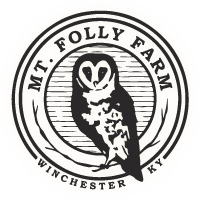Dear Friends,
Last week we hosted a garden club here. We talked first at the Homestead Cabin, then toured on a tractor-pulled farm wagon. Necessarily, these tours are but a snapshot of what we do at Mt. Folly. One of the most innovative undertakings for the year (and for many years to come, I believe) is making biochar.
You may have heard of terra preta, the black soil made centuries ago by indigenous Americans. Similar soils have been found in Africa and in the Caribbean. This soil is dark and fertile because early native farmers had figured out how to use the carbon in wood to increase the organic matter and fertility of thin, fragile, forest and island soils.
Fast forward to today and Mt. Folly, where we have been working hard to improve soils to sequester carbon by building organic matter, shortening supply chains, and reducing fossil fuel use.
Then, we’ve started businesses secured by these short supply chains, Laura’s Mercantile and Wildcat Willy’s Distillery and Restaurant, to market farm products and others like them. The goal of this pilot project is to invent a supply chain and set of businesses which are well on the path to becoming carbon neutral.
So back to biochar.
Trees are dying because of the emerald ash borer. This pest, introduced from Asia and known in the US since 2002, has killed millions of trees, and most likely will go on to kill billions. At Mt. Folly, we’ve lost thousands.
This tree death is tragic, the tragedy compounded by the likelihood that the dead trees will decay on the forest floor, releasing the carbon held tight in the wood tissue back into the atmosphere.
But what if those trees can be milled for lumber or, through pyrolysis, made into charcoal? We decided to give this a try.
Our first test was primitive but succeeded. Our milling worked well, too. The next step is to learn more about a collier’s (a person who makes charcoal) job, and who better to show us than the man who restored the largest charcoal-fired iron furnace in the world, the nineteenth-century Fitchburg Furnace?
So, our story begins. Follow us on Facebook and Instagram to learn more and see how our organic hemp crop takes root this year in biochar-enriched soil, paired with a buckwheat cover crop for buckwheat/hemp honey!
Laura
P.S. If you have a group of 15 or more which would like to tour the farm, please send me an email.


